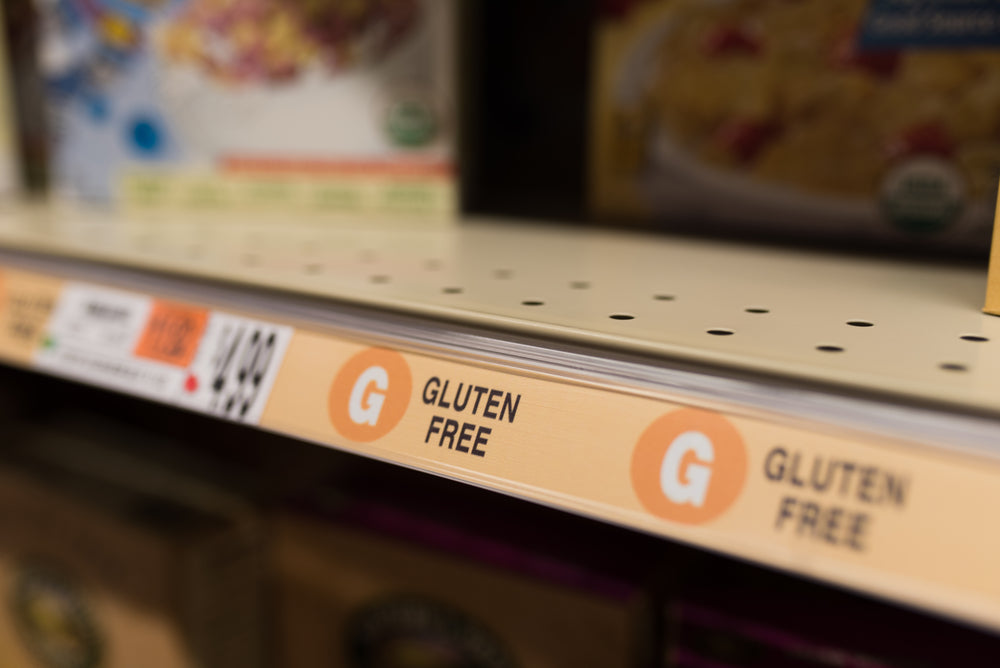
If you’re one of the 1 in 133 Americans living with Celiac Disease, or the 1 in 6 Americans who are gluten-sensitive, you know the diet that best manages your symptoms can be a challenge.
People with Celiac Disease have an autoimmune reaction to the presence of gluten, a protein found in wheat, rye, and barley, which can destroy the sensitive absorptive tissue in the small intestine. One detrimental consequence is that food and nutrients cannot be absorbed and used.
Common symptoms of Celiac Disease include intestinal symptoms such as bloating, gas, and diarrhea, and weight loss, poor growth, and nutritional deficiencies. Individuals with gluten sensitivity, though their symptoms on exposure to gluten may be similar, do not experience the severe intestinal damage observed with Celiac Disease.
The only known definitive diagnostic tool for clarifying the problem is an intestinal biopsy in which the integrity of the intestinal tissue (villi) is visibly observed and evaluated. Trying to eliminate wheat, barley and rye (natural sources of gluten) is the easiest way to become painfully aware of just how ubiquitous the ingredient is in our food culture.
It is important, for overall well-being, to remember that following a gluten-free diet is as much about what to include as it is what to eliminate. The more nutritionally complete your diet is, the less likely it is that gluten-free eating creates other health issues. Six key goals for balanced, gluten-free eating, when accounted for in food and meal planning can help you to feel better, and improve your short and long-term health.
Growing Naturals Rice and Pea Proteins can help you to achieve many of these goals.
Relieving Symptoms with Gluten-Free Grains
First and foremost, it is important to become aware of where gluten is found. It is a protein that naturally occurs in wheat, rye, and barley. The most obvious dietary changes will need to be eliminating foods in which these ingredients are included.
Fortunately, there are a wide variety of options available for sandwiches, pizza crusts, etc., that can ease the transition. In addition, many alternative grains have been embraced and promoted by chefs and creative gluten-free eaters on the internet, providing variety and inspiration to those individuals interested in spicing up their new way of eating.
Here is a list of alternative grains currently available on the market for you to incorporate into your gluten-free cooking.
- Amaranth
- Arrowroot
- Bean and Legume Flours (garbanzo, lentil, pea)
- Buckwheat
- Rice Bran
- Corn
- Flax
- Indian Ricegrass
- Mesquite Flour
- Millet
- Nut Flours (almond, hazelnut)
- Potato Flour
- Potato Starch
- Quinoa
- Polished White Rice
- Brown Rice
- Rice Bran
- Sorghum
- Soy
- Sweet Potato Flour
- Tapioca
- Teff
(Source: Case, S. Celiac Disease, Gluten Sensitivity and the Gluten-Free Diet. http://www.glutenfreediet.ca/img/CD-GS-GFD.pdf).
Depending on the severity of your diagnosis and symptoms, it is important to also keep in mind that gluten residual may work its way into products prepared and/or packaged in facilities where gluten-containing grains are also prepared and packaged. This can be an issue even with foods that are not grain-based, but which are packaged in facilities where these grains ARE.
Growing Naturals products are gluten-free and meet FDA standard of less than 20ppm gluten. Though most times they test well below this at 5 to 10 ppm gluten.
Healing and Maintaining Health
A healthy gluten-free diet is not just about avoiding certain grains. It is about ensuring that all essential nutrients are included in the diet, even when a major source of certain vitamins and minerals has been eliminated.
Dietary iron, calcium, vitamin D, and fiber, are often deficient in people with Celiac Disease. So it is important to seek out foods that reduce the potential influences these omissions may have on regaining total health.
Iron
One serving of Growing Naturals rice protein powder contains 10-15% of the recommended Daily Values (DV) of iron. One serving of pea protein contains 30% of the recommended DV of iron. In addition to red meat, poultry and fish, plant foods that can help you to enhance your iron intake include: green leafy vegetables, dried herbs, dark chocolate, pumpkin and squash seeds, dried tomatoes, and dried fruits like apricots and raisins.
If you make sure you eat these foods along with foods containing vitamin C, and moderate your use of coffee, tea, soybeans, tofu, dairy products, and calcium supplements at meals where you have included your iron foods, you will help that iron to be better absorbed and used.
Calcium
Some of the best foods containing calcium are not dairy products! Collard greens, turnip greens, tempeh, kale, okra, bok choy, mustard greens, Swiss chard, broccoli, basil, thyme, dill seed, and oregano are all respectable sources of this important mineral. In moderation (because they can interfere with iron absorption), consider incorporating tofu and non-genetically modified (GMO) soy products.
Also containing calcium in respectable quantities are: romaine lettuce, celery, fennel, cabbage, summer squash, green beans, garlic, Brussels sprouts, oranges, asparagus, leeks, Crimini mushrooms, rosemary, cumin seeds, cloves, coriander, scallops, and kelp.
Vitamin D
Bone health is an issue in people following gluten-free diets. Vitamin D is not an easy nutrient to get in the diet, especially if you are also eliminating dairy products. Fortunately, one serving of Growing Naturals Rice Drink contains 30% of your recommended Daily Value. In addition to fortified foods, other good sources of vitamin D include sardines, salmon, eggs, and ultraviolet light-exposed mushrooms. Alternately, a non-food source is exposure to direct sunlight for 10-15 minutes preferably at noon.
Accommodating Other Intolerances
People with Celiac Disease often have other intolerances. Even if they are not entirely lactose intolerant, they may need to avoid milk in the early stages of healing. In addition to lactose, food intolerances and allergies often coexisting with gluten issues include: soy, lactose, whey, corn, and nuts.
Growing Naturals products are soy-free, dairy-free, corn-free, nut-free; hence, the tagline, “Finally, a food for all people.”
Reducing Overall Inflammation
Food intolerances and allergies irritate the body and create an inflammatory state that can affect other organs and tissues. Common chronic diseases like heart disease, type II diabetes, polycystic ovary syndrome, arthritis, asthma, even depression, are conditions that often get their jump-start when a diet is strongly pro-inflammatory.
In addition to managing and healing inflammation in your digestive tract, dietary choices can reduce your risk or help to manage symptoms of other conditions.
Two of the most important dietary strategies for reducing inflammation are limiting omega-6 fatty acids from the diet and limiting simple sugars.
Fatty Acid Balance
In general, your daily omega-6 to omega-3 ratio should not exceed 10 to 1 if you are trying to reduce inflammation; be sure you read your labels and moderate quantities of products containing added fats and oils that may make it hard to keep your overall diet in good anti-inflammatory balance.
Almond milk in particular contains no omega-3 fats and is predominantly composed of omega-6 fats.
Some common food sources of omega 6 fats include: sunflower, safflower, soy, sesame and corn oils, walnuts, avocado.
Added Sugar
Many milk alternatives are high in added sugar, so try to choose unsweetened or low sugar versions whenever possible.
Percent of carbohydrates that are added sugar by type of milk
100 Flax
86-90 Coconut Milk in a Carton
79 Oat
78 Hazelnut
75 Hemp
0 Almond
Growing Naturals proteins are sweetened with small amounts of rice sugar, and coconut sugar. In general, pea proteins contain no more than 3g of added sugar per serving and rice proteins contain 0g added sugar per serving.
Reducing Risk of Diabetes
While there is an increased prevalence of celiac disease with type I diabetes, no such correlation with type II diabetes has been recognized in the literature. Even so, as the prevalence of obesity continues to grow in our culture, the number of people managing both conditions is increasing.
If you have any family history of diabetes, or you have been told you have polycystic ovary syndrome or metabolic syndrome, it is important to eat enough protein to support healthy hormone function. One thing you may not realize just how insistent your sweet tooth is, until you realize that gluten-free eating entails cutting out some of your favorite guilty pleasures!
Be careful that your quest for eating gluten-free is a quest for overall health, and not a way to eat food that is gluten-free but still low in nutrient density.
In conclusion, following a gluten-free diet primarily entails switching out grain-based foods containing gluten for grains that do not contain gluten. Your options in every other food category are still wide open and available for you to use creatively in your own personal kitchen!
Growing Naturals Rice and Pea Proteins can be valuable allies in making sure you are getting all of the nutrients in amounts and proportions that launch you into the world of better eating for better health.
For more information on gluten-free eating, please visit: www.glutenfreediet.ca
